
Macaria fissinotata, the hemlock angle, is a moth of the family Geometridae. It is found in North America from Nova Scotia to Georgia, west to Kentucky, north to Ontario.
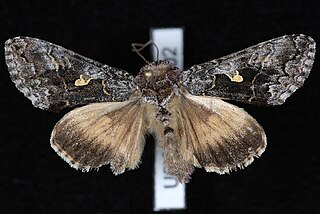
Syngrapha celsa, the plain silver Y or western conifer looper, is a moth of the family Noctuidae. The species was first described by Henry Edwards in 1881. It is found in North America from British Columbia to California, Idaho, Nevada, Arizona and New Mexico.

Tetracis is a genus of moths in the family Geometridae erected by Achille Guenée in 1858.

Protoboarmia porcelaria, the porcelain gray or dash-lined looper, is a Geometrid species of moth found throughout North America, except in the far north. The species was first described by Achille Guenée in 1857.

Nematocampa resistaria, the filament bearer, bordered thorn or horned spanworm moth, is a moth of the family Geometridae. The species was first described by Gottlieb August Wilhelm Herrich-Schäffer in 1856. It is found in North America from British Columbia to Nova Scotia, south to Florida and California.
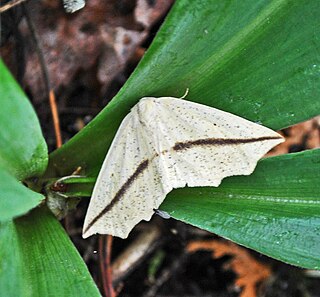
Tetracis crocallata is a moth of the family Geometridae first described by Achille Guenée in 1858. It is found in North America from Nova Scotia, New Brunswick, southern Manitoba and southern Saskatchewan to Alberta, south to northern Florida, west to Kansas, Nebraska, North Dakota and extreme eastern Texas.
Tetracis australis is a moth of the family Geometridae. It is found from the coastal southern regions of the U.S. state of California from Monterey County south to Los Encinas, San Pedro Martir, Baja California, Mexico, at altitudes from near sea level to 2,135 meters.

Tetracis cachexiata, the white slant-line or white slaut, is a moth of the family Geometridae. The species was first described by Achille Guenée in 1858. It is found in North America from Nova Scotia to central British Columbia, south to northern Florida and west to Montana and northern Colorado.

Tetracis cervinaria is a moth of the family Geometridae first described by Alpheus Spring Packard in 1871. It is found in North America from British Columbia south to Kern County, California and eastward to western Montana, south-eastern Idaho, Carbon County, Wyoming and Larimer County, Colorado. It is found at elevations of 790 to 2,375 meters.
Tetracis mosesiani is a moth of the family Geometridae. It is found coastal California from near sea level to 915 meters.
Tetracis jubararia is a moth of the family Geometridae. It is found in North America.
Tetracis barnesii is a moth of the family Geometridae. It is found from the high-desert riparian canyons in Colorado and Utah to the dry coniferous forest in Oregon on altitudes between 1,555 and 1,905 meters.
Tetracis formosa is a moth of the family Geometridae first described by George Duryea Hulst in 1896. It is found in North America from Colorado, eastern Utah and eastern Wyoming west to California and north to southern British Columbia and southern Alberta at elevations between 870 and 2,320 meters.
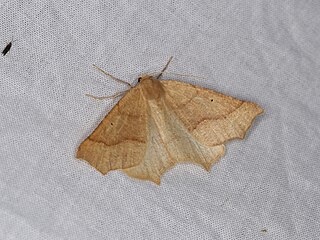
Tetracis hirsutaria is a moth of the family Geometridae first described by William Barnes and James Halliday McDunnough in 1913. It is found in the United States in California and extreme southern Nevada.
Tetracis pallidata is a moth of the family Geometridae first described by Clifford D. Ferris in 2009. It is found in British Columbia, Idaho and Washington.
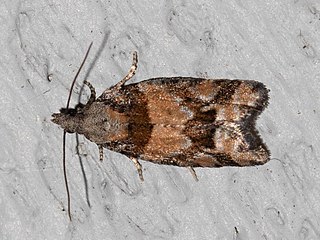
Epinotia radicana, the red-striped needleworm moth, is a species of moth of the family Tortricidae. It is found in western Canada, including British Columbia and Alberta.

Gabriola dyari, or Dyar's looper, is a moth of the family Geometridae first described by Taylor in 1904. It is found from the Alaskan panhandle and British Columbia to California. The habitat consists of coniferous forests.
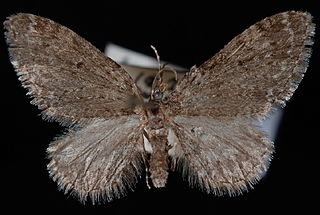
Eupithecia annulata, the larch pug moth, is a moth in the family Geometridae. The species was first described by George Duryea Hulst in 1896. It is found in North America from British Columbia north to the Yukon, east to Newfoundland and Labrador and south to California and Colorado.

Eupithecia olivacea is a moth in the family Geometridae first described by Taylor in 1906. It is found in North America from British Columbia south through Washington and Oregon to California.













